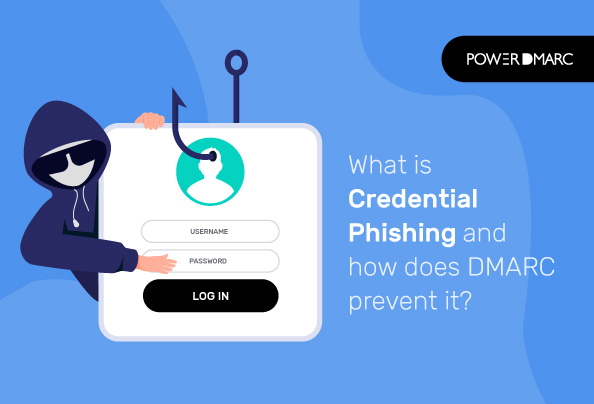Credential phishing tactics are not new. In fact, this type of social engineering attack has been used to trick people into revealing secure information for as long as email has existed. The only difference now is the way cybercriminals are thinking about how to design these attacks. They’re relying on new technology and more believable social engineering tactics. But at its core credential phishing attacks work because they play on human’s trust in an organization.
DMARC is a viable solution that can be leveraged by domain owners to protect their organization against credential phishing attacks..
What is Credential Phishing?
Just like spear-phishing and whaling, credential phishing is a popular form of phishing attack launched by attackers wherein they use digital manipulation, often combined with the force of psychological pressure to break a user’s defenses and make them fall prey to their tactics. In recent times, 96% of all phishing attacks start with fraudulent emails that are often sent in the garb of trusted organizations. Credential phishing is no different in that aspect.
Often perpetrated using fake emails, it creates a sense of urgency among receivers with eye-catching subject lines. These emails are designed using sophisticated social engineering tactics that can easily evade spam filters and generic security gateways by spoofing valid organizational domains. Inside the email body, there is often a malicious link which when clicked on redirects the receiver to a page asking for either of the following credentials:
- Banking credentials which the attacker then uses to wire money transfers into an attacker-controlled bank account
- Corporate credentials (in case the victim is an employee of the spoofed company) which the attacker then uses to gain access to company databases and steal sensitive information and assets
Either way, credential phishing campaigns instigates a sense of exigency among email receivers, while launched by attackers while impersonating a reputed organization can drastically impact the company’s credibility and good name. It can lead to the loss of data and financial assets, as well, and hurt email marketing efforts.
For a business that specializes in custom websites, such a phishing attack can be particularly devastating as it can damage the reputation of the business and make it difficult to attract new clients. It’s important for any company offering online services to take steps to protect their clients’ data and assets and to be vigilant about phishing attempts that may target their clients or their own organization.
How Does DMARC Prevent Credential Phishing?
DMARC is a powerful email validation system that was created to address phishing attacks and improve email security across the Internet. DMARC builds on pre-existing protocols like SPF and DKIM. They help validate your outbound emails by checking email headers for domain alignment. DMARC allows domain owners to set down a policy for fake emails, and choose whether they want to quarantine them or block them out. Subsequently, it keeps credential phishing attacks at bay and minimizes its success rate.
Configuring DMARC involves changing a few DNS configurations by publishing a DMARC record in your domain’s DNS. Manually creating a record can leave room for human error, hence, you can use a DMARC record generator to serve the purpose. DMARC helps reduce the risk of fraudulent activities on your domain while improving your email deliverability rate by almost 10% over time.
How to Read Your DMARC Reports Easily?
When configuring DMARC for your domains, you have the choice to enable DMARC reporting for them. DMARC aggregate reports provide granular details on email sending sources helping you view your authentication results, measure email performances and track malicious senders faster. Webmasters, email service providers, and sending domains use DMARC aggregate reports to monitor and evaluate whether the emails they send are being authenticated and how those email messages are performing. These reports help them monitor non-compliant domains and senders, measure the success rate of their authentication and identify any new threats in a timely manner.
However, DMARC reports are sent in Extensible Markup Language, which can appear indecipherable to non-technical individuals. A DMARC report analyzer provides you with a platform where these XML files are parsed into a simpler, readable, and organized format that helps you view your reports on a colorful dashboard. It also allows you to view the results for multiple domains and sending sources at the same time, and filter results by:
Per sending source
Per host
Per result
Per country
Per organization
Geolocation
Detailed stats
Give your organization the boost of email security it rightfully deserves, by signing up for your DMARC analyzer today!
- Rise in Tax Scams and IRS Email Impersonation Attacks During Tax Season - May 2, 2024
- Email Safety 101 to Fight Crypto Scams - April 30, 2024
- How to Find the Best DMARC Solution Provider for Your Business? - April 25, 2024
